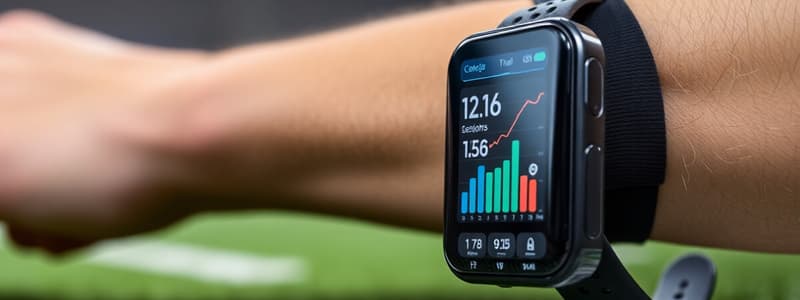Podcast
Questions and Answers
What does the acute chronic workload ratio help to quantify?
What does the acute chronic workload ratio help to quantify?
- Training load changes over time (correct)
- The impact of nutrition on performance
- Team dynamics in sports
- Injury recovery times
A value of 1.0 in the acute chronic workload ratio indicates what?
A value of 1.0 in the acute chronic workload ratio indicates what?
- Acute workload greatly exceeds chronic workload
- Acute and chronic workloads are equal (correct)
- Chronic workload is double the acute workload
- Training has increased significantly over the last month
What does an acute chronic workload ratio above 1.5 indicate?
What does an acute chronic workload ratio above 1.5 indicate?
- Consistent training load
- Optimal training conditions
- Low risk of injury
- Increased likelihood of injury (correct)
What time frame is commonly used for the acute workload in studies?
What time frame is commonly used for the acute workload in studies?
Which of the following best describes the chronic workload period commonly used?
Which of the following best describes the chronic workload period commonly used?
What is the primary goal of using wearable technology in sports training?
What is the primary goal of using wearable technology in sports training?
What role does machine learning play in managing athletic training?
What role does machine learning play in managing athletic training?
What technology was used in the scientific study to gather data during boxing?
What technology was used in the scientific study to gather data during boxing?
How accurate was the machine learning model in detecting different striking patterns in boxing?
How accurate was the machine learning model in detecting different striking patterns in boxing?
What is a significant challenge mentioned regarding athletic training?
What is a significant challenge mentioned regarding athletic training?
What type of data were the sensors from the catapult device able to collect?
What type of data were the sensors from the catapult device able to collect?
What is one application of machine learning discussed in the context of sports?
What is one application of machine learning discussed in the context of sports?
Why is determining the optimal training amount important for athletes?
Why is determining the optimal training amount important for athletes?
What does the acute chronic workload ratio primarily compare?
What does the acute chronic workload ratio primarily compare?
How long is the acute phase typically measured?
How long is the acute phase typically measured?
What is the purpose of calculating the acute chronic workload ratio?
What is the purpose of calculating the acute chronic workload ratio?
How long is the chronic phase generally measured?
How long is the chronic phase generally measured?
What controversy exists regarding the acute chronic workload ratio?
What controversy exists regarding the acute chronic workload ratio?
What is the primary focus of the acute chronic workload ratio as per the current context?
What is the primary focus of the acute chronic workload ratio as per the current context?
What has previous research suggested about the relationship between the acute chronic workload ratio and injury?
What has previous research suggested about the relationship between the acute chronic workload ratio and injury?
What does the chronic phase of the acute chronic workload ratio measure?
What does the chronic phase of the acute chronic workload ratio measure?
Flashcards
Acute Chronic Workload Ratio
Acute Chronic Workload Ratio
The ratio of short-term workload (acute phase, usually one week) to long-term workload (chronic phase, usually 3-6 weeks).
Acute Phase
Acute Phase
Represents the athlete's most recent workload, typically encompassing the past week.
Chronic Phase
Chronic Phase
Reflects the athlete's training load over a more extended period, usually the last 3-6 weeks.
Injury Risk Prediction
Injury Risk Prediction
Signup and view all the flashcards
Too Much Too Soon
Too Much Too Soon
Signup and view all the flashcards
Gradual Training Volume Increase
Gradual Training Volume Increase
Signup and view all the flashcards
Machine Learning in Athlete Monitoring
Machine Learning in Athlete Monitoring
Signup and view all the flashcards
ACWR and Injury Causality
ACWR and Injury Causality
Signup and view all the flashcards
Machine Learning
Machine Learning
Signup and view all the flashcards
Acute to Chronic Workload Ratio (ACWR)
Acute to Chronic Workload Ratio (ACWR)
Signup and view all the flashcards
Accelerometers and Gyroscopes
Accelerometers and Gyroscopes
Signup and view all the flashcards
Boxing Punch Prediction Study
Boxing Punch Prediction Study
Signup and view all the flashcards
Wearable Technology in Sports
Wearable Technology in Sports
Signup and view all the flashcards
Optimal Training Load
Optimal Training Load
Signup and view all the flashcards
Catapult Device
Catapult Device
Signup and view all the flashcards
Injury Prevention and Performance Optimization
Injury Prevention and Performance Optimization
Signup and view all the flashcards
Acute Workload
Acute Workload
Signup and view all the flashcards
Chronic Workload
Chronic Workload
Signup and view all the flashcards
High ACWR
High ACWR
Signup and view all the flashcards
ACWR of 1.0
ACWR of 1.0
Signup and view all the flashcards
Study Notes
External Sensors and Injury Prevention
- External sensors are used to try and predict and prevent injuries in athletes.
- Long training loads can lead to injuries, but too little training results in poor performance.
- Wearable technology enables better characterization of training.
- Machine learning algorithms analyze data to predict injury risk or optimal training loads.
Wearable Devices in Boxing
- A study used wearable sensors (accelerometers and gyroscopes) on boxing gloves and wrists.
- Machine learning algorithms analyzed sensor data to predict the type of punches thrown.
- Accuracy of prediction was about 90%.
- This demonstrates sensors can differentiate different striking patterns.
Acute-to-Chronic Workload Ratio
- This ratio compares short-term (acute) workload to long-term (chronic) workload.
- It's calculated by measuring training volume in recent days/weeks to the preceding months.
- External measures are used to determine this ratio.
- It helps predict injury risk.
- High ratios (above 1.5, especially 2.0) indicate a high risk of injury.
- A ratio of 1.0 suggests the current training week's workload is similar to the training load of the past month.
- Coaches and trainers use this data for planning better training regimens.
Workload and Injury Risk
- Recent studies suggest a measurable relationship between acute-chronic workload ratios and injuries.
- Athlete and team coaches use this to manage training loads appropriately.
- The workload ratio can help predict injury risk.
- A ratio above 1.5 or 2.0 signals a higher risk of overuse injury
Studying That Suits You
Use AI to generate personalized quizzes and flashcards to suit your learning preferences.





